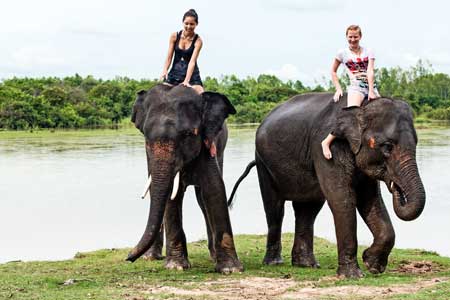How travellers should stop animals abuse!? When a traveller makes plans to visit a new country, it is important for them to think about the impact that travel experience will have on the place they are visiting, as well as on the nature of travelling as a whole.
It is most important to consider the ethical, or not so ethical, practices and implications of the attractions travelers may plan into their trips abroad.
One application of these traveller ethics is in the consideration of travelling to foreign countries who market animal attractions as reasons to visit their destination. What if the decisions we make could help to stop animals abuse?
“Countries all over the world are made attractive to professional travellers by the exploitation of fascinating, exotic animal attractions.” Why can’t we stop Animals Abuse??
Name an exotic animal and there is likely a theme park created in their name. Sea World in Orlando , Florida and Gatorland in Tampa, Florida are two of the most well-known of the animal themed parks in the United States, but these attractions are present in many more places than just the USA. As of 2016, the Association of Zoos and Aquariums (AZA) recorded 232 accredited zoos and aquariums in 9 of the world’s countries.
These include 18 safari and theme parks. Bear or alligator parks, safari tours, dolphin and whale shows and circuses are all created to showcase exotic wildlife. Though many of these institutions are regulated and sanctioned by organizations that will help to ensure no animals abuse occurs within them, many more are created and run as unsanctioned (unregulated) businesses, which makes it even more likely for animal abuse to occur.
In even regulated parks and animals are fenced into enclosures and trapped behind glass walls in order to be readily available for viewing by tourists interested in seeing a culture’s local wildlife.
But these animals are not wild, they are trapped inside what could be deemed grande petri dishes, made readily available for examination. Even the caging of animals could be deemed a type of animal abuse, removing them from their natural habitat.
Beyond large scale animal parks, smaller operations including snake charming and dancing monkeys displayed on street corners have become tourist attractions in countries from India to the Philippines.

These attractions are built with the idea in mind that the spectacle of performing animals attracts visitors and profit, and in the case of countries abroad, this includes attracting travelers.
So the question becomes, how and when do we travelers decide that a spectacle is one that might be supporting abuse of the animals that help make it so spectacular?
It makes sense at first glance that a zoo or animal attraction would be entertaining; Animals are intriguing creatures and from a young age we are encouraged to seek out close encounters with animal life at zoos and in nature to stimulate our desire for knowledge and experience.
The pursuit of experiences with animal life is a valid reason to travel, but the important thing to remember as a when planning these types of animal encounters into our travel plans is the difference between the experience of witnessing animals in nature and the viewing or interacting with them in captivity.
Animals kept captive or trained to interact with humans for entertainment purposes are huge attractions for travelers. One well known example of this practice is elephant riding in places like Vietnam and Thailand. Elephant rides are marketed as a once in a lifetime experience, and it seems exciting and fun.
It is an experience like nothing you would have with a wild elephant, and that is the point where we should begin to question whether or not we are meant to be riding them. These animals that should be wild, are instead tamed in order for travelers to have the opportunity to ride and interact with them.
By taking these animals out of their natural environment, we are putting them at risk, and subjecting them to animal abuse or Do you want to Stop Animals Abuse right now?? Actually 100% your choice.
First, we are inherently violating a wild animal’s natural protections by interacting with them. For instance, sea turtles on the coasts of island destinations like Hawaii are put at risk by human contact due to the fact that our touch removes bacteria on the animal’s shell that protects them from disease.
This means that because of our desire to take photographs with this great endangered species and make a memory by touching a wild animal, we are in turn exposing these animals to illness and pain. This information might be a surprise to many tourists who think their photos and poses are harmless mementos of a fun trip to an exotic place.

As ethical travelers, it is our duty to know the inherent risk we pose to wild animal species and to stop these types of animals abuse that happen by our very own interaction with them.
Furthermore, beyond the accidental harm we can inflict on animal life when travelling, many animals in captivity are subject to abuse by their handlers. For instance, let us return to the example of Elephant riding in Vietnam. The very fact that we can ride these elephants is a result of the fact that they have been tamed.
Taming an animal means separating them as babies from their natural habitat, sometimes even from their mothers at birth and at its harshest, literally whipping and starving the wildness out of them. Bullhooks, essentially a large metal or wooden poking stick, are used in the taming and training of elephants and can inflict wounds on the elephants’ sides from aggressive prodding.
It is the fear of these bullhooks and the pain they inflict that makes the creatures move forward when a person is riding on top of them.
Finally, elephants are not made to support the weight of a human being as their backs are not developed to support weight. Therefore, by riding elephants travelers are not only supporting the abusive industry that tames them, but they are themselves causing the creature pain by the very act of riding on their fragile backs.
And so there are many ways we can work together as travelers to stop the animal abuse that is supported by the travel industry’s attraction to wild animal experiences.
We can be thoughtful when researching the attractions available at any one destination we wish to visit, and steer clear of animal riding and even the so called “sanctioned” animal parks that might harm the animals housed within their walls.
Additionally, when we encounter animals in their natural habitat, we can give them the space necessary to keep them free of any diseases we might pass along to them via contact.
Your little help would Stop Animals Abuse
Travel is fun because we are seeking adventure and ways to experience the wild world around us to its full extent, but as we plan our exploration of that world and all the exotic animal life it holds, we must keep the potential for abuse of that wildlife in mind.
It is important for us to remember that just because we have a curiosity, that doesn’t mean we should indulge it. As we leave our own countries to explore we need to consider the nature of the activities we will participate in when we visit a new place.
What effect will our participation in an activity like attending an animal theme park or circus show have on the animals involved, and will it support a negative aspect of animal tourism as a whole, or will our actions as we travel help to stop animals abuse in the long run?
 TravellerHints!
TravellerHints! 